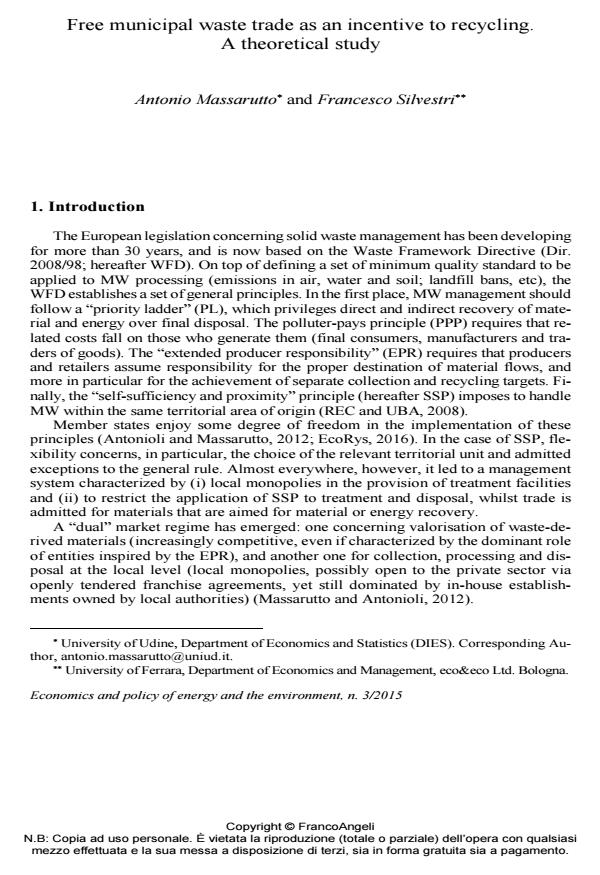Free municipal waste trade as an incentive to recycling. A theoretical study
Journal title ECONOMICS AND POLICY OF ENERGY AND THE ENVIRONMENT
Author/s Antonio Massarutto, Francesco Silvestri
Publishing Year 2016 Issue 2015/3
Language English Pages 19 P. 89-107 File size 739 KB
DOI 10.3280/EFE2015-003005
DOI is like a bar code for intellectual property: to have more infomation
click here
Below, you can see the article first page
If you want to buy this article in PDF format, you can do it, following the instructions to buy download credits

FrancoAngeli is member of Publishers International Linking Association, Inc (PILA), a not-for-profit association which run the CrossRef service enabling links to and from online scholarly content.
According to the Self-Sufficiency and Proximity Principle (SSP), municipal waste (MW) disposal has to be confined within delimited territorial zones, with no trade allowed. The justification is usually the need to make each community aware of its environmental responsibility and discourage diversion of MW to "waste havens". In this paper, we explore the possible benefits associated with some opening to MW treatment service trade. We assume that some areas are equipped with MW treatment facilities, while others are not. We demonstrate, under standard assumptions, that removing SSP and allowing trade of MW disposal services between such regions may foster MW selection in both areas. This is true not only when disposal capacity is constrained, so that a part of the original demand for MW diversion is unsatisfied, but also when it is unconstrained and can accommodate all the residual unsorted MW, provided that the design of rewarding schemes is appropriate. On the contrary, if both districts were equipped with a facility, the same would not be true, and each one would be more willing to exploit the plant’s capacity before engaging in efforts to reduce waste. JEL classification: olid waste, waste management, disposal facilities, waste trade, regulated markets.
Keywords: L43, L99, Q53, R11
- A circular economy model based on biomethane: What are the opportunities for the municipality of Rome and beyond? Idiano D’Adamo, Pasquale Marcello Falcone, Donald Huisingh, Piergiuseppe Morone, in Renewable Energy /2021 pp.1660
DOI: 10.1016/j.renene.2020.10.072 - Direct and indirect effects of EU Self Sufficiency Principle on Municipal Waste Management: A theoretical approach Francesco Silvestri, in ECONOMIA PUBBLICA 1/2019 pp.89
DOI: 10.3280/EP2019-001005
Antonio Massarutto, Francesco Silvestri, Free municipal waste trade as an incentive to recycling. A theoretical study in "ECONOMICS AND POLICY OF ENERGY AND THE ENVIRONMENT" 3/2015, pp 89-107, DOI: 10.3280/EFE2015-003005